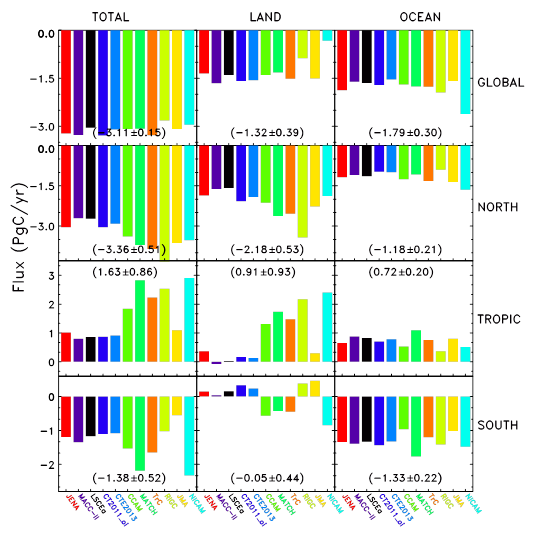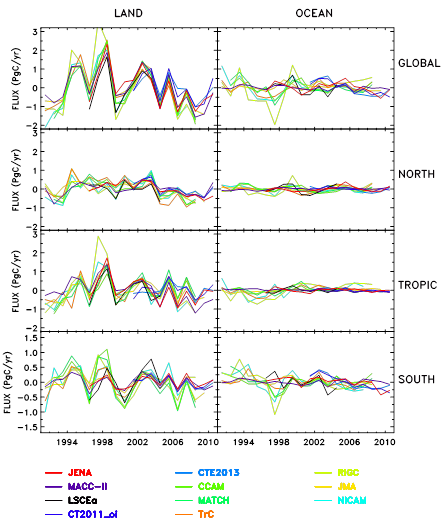Part 1. Optimising surfaces fluxes with atmospheric CO2: strength & weaknesses
Up to recently atmospheric CO2 data have been used to optimise surface CO2 fluxes after the inversion of the atmospheric transport (see main presentation for the principle). Several groups have used different transport mode, different prior flux information, l and different inversion schemes. Main differences are
- The spatial esolution of the surfaces fluxes that are optimized: from each model grid pixel to large scale regions (22 in some cases)
- The temporal resolution of the fluxes: from monthly to weekly
- The algorythm to minimize the cost function: either based on a matrix formulation or on a variational approach (see main presentation)
- The transport model resolution: from 1 degree grid to 4 degree grid resolution
- The type of re-analysed wind fields: from different meteorological institute (ECMWF, NCEP, ...)
- The prior fluxes that will be further optimized: using different biosphere model for the land, different ocean estimates, and different fossil fuel emissions
- The prior flux errors and errors covariances
11 inversions are compared below. Their main characteristic are provided in Table 1:
Table. Participating inversion systems and key attributes
| Acronym |
Refence |
# of regions |
Time period |
Obs1 |
# of obs locations2 |
IAV wind3 |
IAV priors4 |
| LSCEa |
Piao et al, 2009 |
Grid-cell (96x72) |
1996-2004 |
MM |
67 |
Yes |
No |
| MACC-II |
Chevallier et al, 2010 |
Grid-cell (96x72) |
1988-2011 |
Raw |
134 |
Yes |
Yes |
| CCAM |
Rayner et al, 2008 |
146 |
1992-2008 |
MM |
73 CO2
7δ13CO2 |
No |
No |
| MATCH |
Rayner et al, 2008 |
116 |
1992-2008 |
MM |
73 CO2
7δ13CO2 |
No |
No |
| CT2011_oi |
Peters et al, 2007 |
156 |
2001-2010 |
Raw |
96 |
Yes |
Yes |
| CTE2013 |
Peters et al, 2010 |
168 |
2001-2010 |
Raw |
117 |
Yes |
Yes |
| JENA (s96, v3.5) |
Rödenbeck, 2005 |
Grid-cell (72x48) |
1996-2011 |
Raw |
50 |
Yes |
No |
| RIGC (TDI-64) |
Patra et al, 2005a |
64 |
1989-2008 |
MM |
74 |
Yes |
No |
| JMA |
Maki et al, 2010 |
22 |
1985-2009 |
MM |
146 |
Yes |
No |
| TrC |
Gurney et al, 2008 |
22 |
1990-2008 |
MM |
103 |
No |
No |
| NICAM |
Niwa et al, 2012 |
40 |
1988-2007 |
MM |
71 |
Yes |
No |
1: Observations used as monthly means (MM) or at sampling time (Raw)
2: Number of measurement locations included in the inversion (some inversions use multiple records from a single location)
3: Inversion accounts for interannually varying transport (Yes) or not (No)
4: Inversion accounts for interannually varying prior fluxes (Yes) or not (No)
Typical results obtained with these inversions are:

Figure 1. Mean natural fluxes for the period 2001-2004 of the individual participating inversion posterior fluxes. Shown here are total (first column), natural "fossil corrected" land (second column) and natural ocean (third column) carbon exchange aggregated over the Globe (top row), the North (2nd row), the Tropics (3rd row) and the South (bottom row), with the three regions divided by approximately 25°N and 25°S (but modified over land areas to keep regional estimates (e.g. northern Africa) in one region; see figure S7 in Supplementary Material). Numbers in parentheses represent the mean flux and the standard deviation across all inversions.

Figure 2. Annual mean anomalies of the individual participating inversion posterior flux estimates. Shown here are the fossil corrected natural land (first column) and natural ocean (second column) carbon exchange for the same regions as Figure 4: the Globe, north (> 25N), tropics (25S-25N) and south (< 25S).
Visit the following web sites to make your own comparison with these inversions:
Questions:
- What are the robust features across the different inversions?
- What are the main causes of flux differences across the different inversions? Try to rank them according to your understanding of the whole inversion process.







